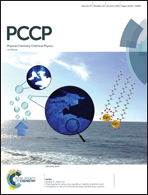Interplay between magnetic anisotropies in CoAu and Co films and antidot arrays: effects on the spin configuration and hysteretic behavior
Abstract
We studied (i) a set of three Co : Au continuous films, grown by sputtering co-deposition (∼80 nm thick) with concentration ratios of 2 : 1, 1 : 1 and 1 : 0 (i.e., a pure Co film was also included), and (ii) a corresponding set of antidot arrays, produced by nanosphere lithography with the same hexagonal pattern (nominal lattice periodicity ∼520 nm). The samples were investigated by atomic and magnetic force microscopy and SQUID magnetometry. A twofold aim was fulfilled: to gain information on the magnetism of the CoAu compound (saturation magnetization, effective in-plane and out-of-plane anisotropy, exchange stiffness constant and magnetostrictive behavior) and to compare the magnetic behavior of the continuous and patterned samples. The continuous films exhibited a variety of hysteretic behaviours and magnetic configurations, ruled by the interplay between different magnetic anisotropy terms (magnetocrystalline, magnetoelastic and shape). The Co1Au1 film was anisotropic in the plane, whereas Co2Au1 and Co were isotropic and had an out-of-plane magnetization component; stripe domains were observed in Co2Au1, resulting in a transcritical hysteresis loop. A key role in determining these properties was ascribed to the magnetoelastic anisotropy term. Unlike the continuous films, the antidot arrays showed a similar hysteretic behavior and important similarities in the spin configuration were pointed out, despite the different compositions. We argue, also based on micromagnetic simulations, that this occurred because the nanopatterning enabled a local modification of the shape anisotropy, thus smoothing out the differences observed in the continuous films.



 Please wait while we load your content...
Please wait while we load your content...